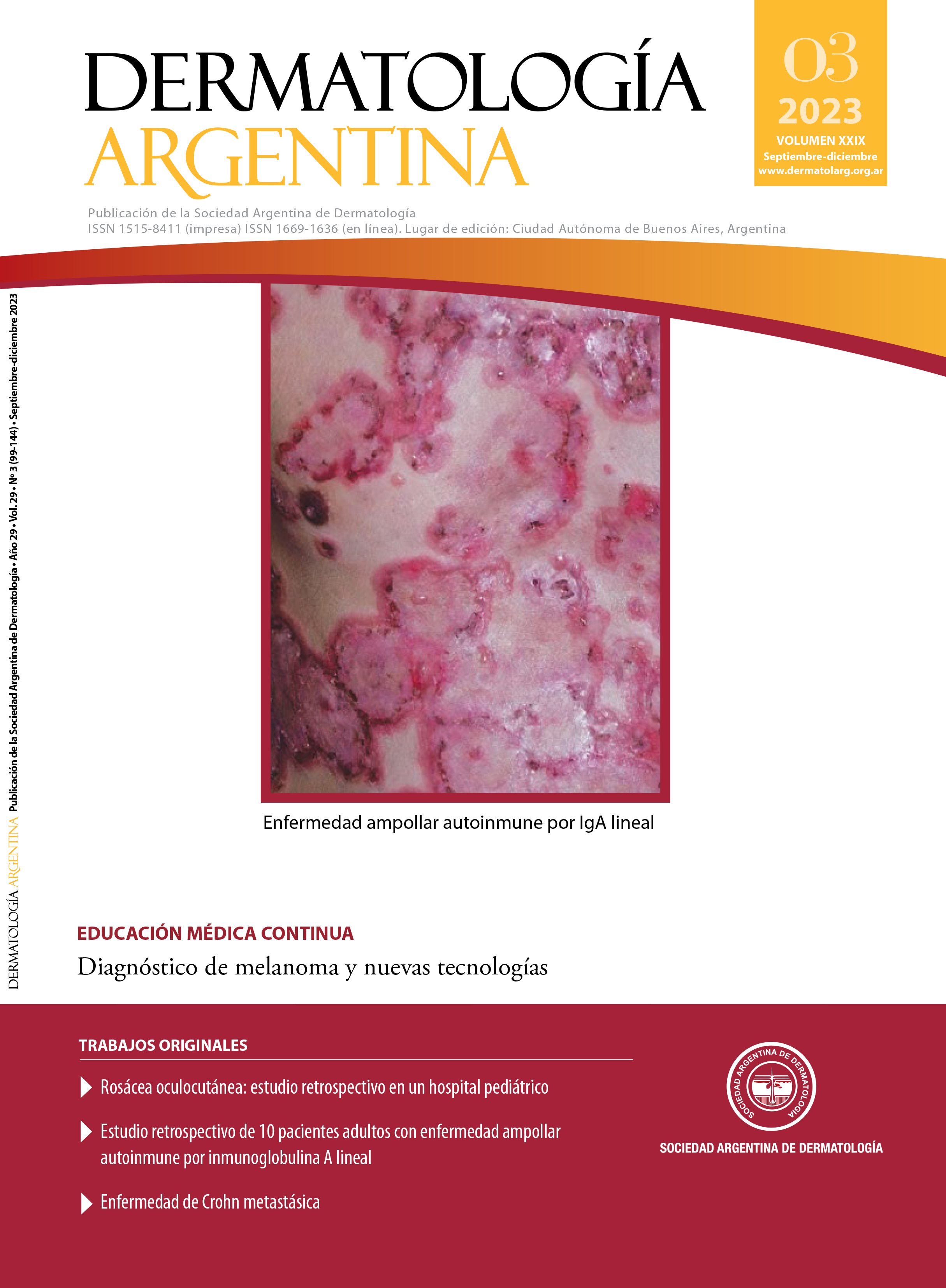Controversies in allergic contact dermatitis
DOI:
https://doi.org/10.47196/da.v29i3.2418Keywords:
allergic contact dermatitis, children, epicutaneous patch test, parabens, immunosuppressantsAbstract
The approach to allergic contact dermatitis is controversial in certain populations such as children, and patients being treated with immunosuppressants or biologics. The possible benefit resulting from the performance of the PT deserves that, without minimizing the challenge, each case has to be evaluated due of the current evidence. Based on our clinical experience and review of the literature, we can also find answers against the disqualification of preservatives such as parabens or against the overvaluation of "natural" products.
References
I. Scheinman PL, Vocanson M, Thyssen JP, Johansen JD, et ál. Contact dermatitis. Nat Rev Dis Primers. 2021;7:38.
II. Neale H, Garza-Mayers AC, Tam I, Yu J. Pediatric allergic contact dermatitis. Part I: Clinical features and common contact allergens in children. J Am Acad Dermatol. 2021;84:235-244.
III. Bruckner AL, Weston WL, Morelli JG. Does sensitization to contact allergens begin in infancy? Pediatrics. 2000;105:e3.
IV. Low KY, Wallace M. Prevalence of potential contact allergens in baby cosmetic products. Clin Exp Dermatol. 2019;44:411-413.
V. Simonsen AB, Johansen JD, Deleuran M, Mortz CG, et ál. Contact allergy in children with atopic dermatitis: a systematic review. Br J Dermatol 2017;177:395-405.
VI. Jacob SE, Lipp MB, Suh E, Goldenberg A. Practice patterns of dermatologists in the pediatric contact dermatitis registry. Pediatr Dermatol. 2017;34:408-412.
VII. Neale H, Garza-Mayers AC, Tam I, Yu J. Pediatric allergic contact dermatitis. Part 2: Patch testing series, procedure, and unique scenarios. J Am Acad Dermatol. 2021;84:247-255.
VIII. Bruusgaard-Mouritsen MA, Johansen JD, Zachariae C, Kirkeby CS, et ál. Natural ingredients in cosmetic products. A suggestion for a screening series for skin allergy. Contact Dermatitis. 2020;83:251-270.
IX. Gilissen L, Huygens S, Goossens A. Allergic contact dermatitis caused by topical herbal remedies: importance of patch testing with the patients' own products. Contact Dermatitis. 2018;78:177-184.
X. de Groot AC. Propolis: a review of properties, applications, chemical composition, contact allergy, and other adverse effects. Dermatitis. 2013;24:263-282.
XI. Kwong HL, Lim SPR. Prevalence of propolis allergy in Singapore. JAAD Int. 2020;1:39-41.
XII. Groot AC, Schmidt E. Tea tree oil: contact allergy and chemical composition. Contact Dermatitis. 2016;75:129-143.
XIII. Martínez-Campayo N, Goday-Buján JJ, Fonseca-Capdevila E. Dermatitis alérgica de contacto por aceite de árbol del té. Acta Derm Venereol. 2020;111:787-788.
XIV. Błędzka D, Gromadzińska J, Wąsowicz W. Parabens. From environmental studies to human health. Environ Int. 2014;67:27-42.
XV. Fransway AF, Fransway PJ, Belsito DV, Warshaw EM, et ál. Parabens. Dermatitis. 2019;30:3-31.
XVI. Nowak K, Ratajczak-Wrona W, Górska M, Jabłońska E. Parabens and their effects on the endocrine system. Mol Cell Endocrinol. 2018;474:238-251.
XVII. Deza G, Giménez-Arnau AM. Allergic contact dermatitis in preservatives: current standing and future options. Curr Opin Allergy Clin Immunol. 2017;17:263-268.
XVIII. Nowak K, Jabłońska E, Ratajczak-Wrona W. Controversy around parabens: alternative strategies for preservative use in cosmetics and personal care products. Environ Res. 2021;198:10488.
XIX. Matwiejczuk N, Galicka A, Brzóska MM. Review of the safety of application of cosmetic products containing parabens. J Appl Toxicol. 2020; 40:176-210.
XX. Lazzarini R, Kawakami NT, Suzuki N, Hafner MFDS. Patch tests in patients using immunosuppressants and/or cytokine inhibitors: descriptive analysis of 16 cases. An Bras Dermatol. 2023;98:99-101.
XXI. Fowler JF Jr, Maibach HI, Zirwas M, Taylor JS, et ál. Effects of immunomodulatory agents on patch testing: expert opinion 2012. Dermatitis. 2012;23:301-303.
XXII. Kim N, Notik S, Gottlieb AB, Scheinman PL. Patch test results in psoriasis patients on biologics. Dermatitis. 2014;25:182-190.
XXIII. Todberg T, Zachariae C, Krustrup D, Skov L. The effect of anti-IL-17 treatment on the reaction to a nickel patch test in patients with allergic contact dermatitis. Int J Dermatol. 2019;58:e58-e61.
XXIV. Martínez-Mera C, González MA, Hospital M, Turrión-Merino L. Isothiazolinones in paint as a cause of airborne contact dermatitis in a patient with psoriasis receiving anti-interleukin-17 therapy. Contact Dermatitis. 2019;80:328-329.
XXV. Shah P, Milam EC, Lo Sicco KI, Cohen DE. Dupilumab for allergic contact dermatitis and implications for patch testing: irreconcilable differences. J Am Acad Dermatol. 2020;83: e215- e216.
XXVI. Jo CE, Mufti A, Sachdeva M, Pratt M, Yeung J. Effect of dupilumab on allergic contact dermatitis and patch testing. J Am Acad Dermatol. 2021;84:1772-1776.
XXVII. Mainville L, Veillette H, Houle MC. Sequential patch testing in a patient treated with dupilumab then with upadacitinib. Differences in patch test results as well as in disease control. Contact Dermatitis. 2023;88: 402‐404.
XXVIII. Johansson SG, Haahtela T, O'Byrne PM. Omalizumab and the immune system: an overview of preclinical and clinical data. Ann Allergy Asthma Immunol. 2002;89:132-138.
XXIX. Mufti A, Lu JD, Sachdeva M, Zaaroura H, et ál. Patch testing during immunosuppressive therapy: a systematic review. Dermatitis. 2021;32:365-374.
Downloads
Published
Issue
Section
License
Copyright (c) 2023 on behalf of the authors. Reproduction rights: Argentine Society of Dermatology

This work is licensed under a Creative Commons Attribution-NonCommercial-NoDerivatives 4.0 International License.
El/los autor/es tranfieren todos los derechos de autor del manuscrito arriba mencionado a Dermatología Argentina en el caso de que el trabajo sea publicado. El/los autor/es declaran que el artículo es original, que no infringe ningún derecho de propiedad intelectual u otros derechos de terceros, que no se encuentra bajo consideración de otra revista y que no ha sido previamente publicado.
Le solicitamos haga click aquí para imprimir, firmar y enviar por correo postal la transferencia de los derechos de autor











